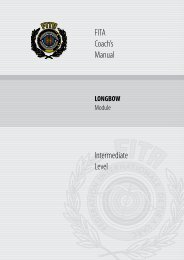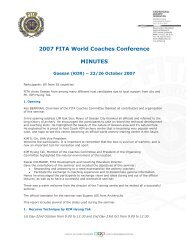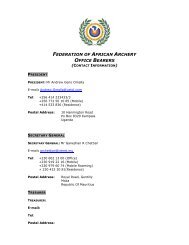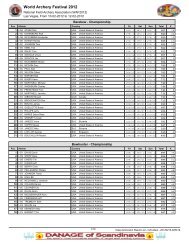Blue Arrow - FITA
Blue Arrow - FITA
Blue Arrow - FITA
You also want an ePaper? Increase the reach of your titles
YUMPU automatically turns print PDFs into web optimized ePapers that Google loves.
<strong>FITA</strong> BEGINNERS MANUAL<strong>Blue</strong><strong>Arrow</strong>44
<strong>FITA</strong> BEGINNERS MANUALCURRICULUM FOR THE <strong>FITA</strong> BLUE ARROW AWARD.PERFORMANCE:Shooting distance:Minimum required score:18 meters115 pointsSKILLS – Your shooting sequence should include the following:String hand: String HookObjective:Consistent finger positioning on the string, about the arrow.Form:The fingers grip the string between thetwo upper joints. The palm of the handis relaxed and the back of the hand isflat.The three fingers share the workload equally.Afterwards, the back of the hand remains asvertical as possible, not curled-up, with thewrist as flat as possible. The interior of theforearm remains relaxed. Consequently, thehand is in the same axis, or vertical plan asthe forearm and arrow.In most of the unsighted methods, threefingers are used and positioned beneath thearrow. In the shaft aiming method (straightline), the space between the nock and theforefinger is about two to three fingers,depending on facial bone structure & size ofstring fingers.With a proper string hook, the backof the hand and the wrist are flat.(Example for sight use.)Rationale:A “deep” string grip in the fingers, allows the muscles of the string hand, arm andforearm to relax from the string side. The more relaxed these body parts are, the lessstring constraints there is, and the string releases cleanly from the fingers.45
<strong>FITA</strong> BEGINNERS MANUALFacial marks:Straight line:Simplification of the quadrilateral to a simple line (see further down in this chapter).Triangle:No :- need to repeat the facial marks at fulldraw (see triangle and quadrilateralmethods described further down); asimple visual alignment of the arrowshaft on the centre of the target isenough.- eye positioning in reference with theshooting plan (hence no need ofstring alignment);- worry about applying a verticalfinger pressure on the arrow (upwardor downward) with the string fingers.The arrow is positioned by two reference points.- arrow point, by visual placement on the target;- arrow nock, through contact of the string hand on the face.46
<strong>FITA</strong> BEGINNERS MANUALTo ensure the triangle reproduction, the archer has to:- maintain a constant draw;- place the eye for string alignment.Quadrilateral:In the triangle method, the aimingeye positioning (for stringalignment) is mandatory.The arrow ispositioned by tworeference points:- the arrowpoint, byvisualplacement of asight on thetarget. Hencea sight should be introduced when teaching this method;- the arrow nock, through tactile placement of the string hand on the face.Furthermore, to ensure the repetition of thequadrilateral method, the archer must maintain:- the bow in the vertical plane, orconstantly canted the same amount;- maintain a constant draw;- place the eye for string alignment.47
<strong>FITA</strong> BEGINNERS MANUAL<strong>Arrow</strong>- String forearm alignment:Objective:Find out the body position allowing a minimum of effort and a maximum of stabilityduring the “full draw ».Form :Your string forearm should be as much aspossible in the vertical plan passingthrough the arrow.Rational :Physically wise this is the positionrequiring fewer efforts. Furthermore itallows to keep relax the muscles of thestring arm, forearm and wrist.This relaxation of the top body limbfacilitates the use of the muscles located inthe back and behind the string shoulder.Feeling attention:In order to better feel your physical (or kinesthetic) perception related to the skill andhand, we suggest to you to shoot at a very short distance (about 3 meters) with eyesclosed. Shooting at an empty buttress (noting to aim at9 also ease the physicalperceptions.KNOWLEDGE&/OR KNOW-HOWBow knowledge:You should be able to give the overall description of 3 types of bow.The following gives a general description of the Recurve, Compound and Standardbow.Recurve:a bow of any type provided it subscribes to the accepted principle and meaning ofthe word bow as used in target archery, that is, an instrument consisting of a handle(grip), riser (no shoot-through type) and two flexible limbs each ending in the tipwith a string nock. The bow is braced for use by a single string attached directlybetween the two string nocks, and in operation is held in one hand by its handle(grip) while the fingers of the other hand draw, hold back and release the string.Compound: A compound bow, which may be of a shoot-through type, is one wherethe draw is mechanically varied by a system of pulleys and /or cams. The bow isbraced for use by bowstring(s) attached directly between the two string nocks of thebow limbs, or attached to the bow cables, as may be applicable to the particulardesign.48
<strong>FITA</strong> BEGINNERS MANUALStandard bow: The bow will be of a simple design, either a take-apart type (whichwooden or metal riser, no shoot-through type) or of one-piece construction. In bothtypes of bow the limbs will be of wood and /or fiberglass construction.<strong>Arrow</strong> reparation: <strong>Arrow</strong> nocks reparation.1. Remove the remaining part of thebroken nock, if any. For an easyremoval you can slightly warm theremaining plastic part of the nockwith a flame.2. Clean the area where the new nockwill fit with 91 % isopropyl alcohol.Beforehand, you can use a fine papersand on the cone of the aluminumshaft.Con carbon and Aluminum shaft youcan clean the area that will receivethe new nock3. Put a drop of glue on the area wherethe new nock will fit, see picture.4. Present the nock on the shaft and rotate it for spreading the glue.5. Orientate the grove of the nock square to the leading vane, see picture.49
<strong>FITA</strong> BEGINNERS MANUALEVALUATION FORM FOR BLUE ARROW CANDIDATESName of the beginner:Form EDate: ____ / ____ / 200__Make up date: ____ / ____ / 200__Shooting Required minimum scoredistancefor scoreevaluation18 meters 115 pointsSKILLSKey elements(What should be done)Achieved*Achieved**Not yetachieved*Not yetachievedFinal number ofhits.References to the<strong>FITA</strong> Level 1Coaching manual#7.1.2.3.aString hand Flat back of hand (no knucklespointed out)3 fingers are used for gripping#7.1.2.3.athe stringVertical back of hand#7.1.2.3.aConsistent grip#7.1.2.3.aFacial marks Are consistent #7.1.2.8Provide “decent” alignment#7.1.2.8between arrow and stringforearm.FeelingattentionSubjects3 evaluationsBowsknowledge<strong>Arrow</strong>reparationTOTALCan align the string. #7.1.2.8Can shoot with eyes closed#9.5 third stepRequired knowledge or knowhow’sAchieved**Not yetachievedComments &7orreferencesCan give the overall descriptionC&R #4.3 relatedof 3 types of bow.book and articlesKnow how to replace a nock #11.4.211 positive evaluations arerequired** Awarded ____or Not awarded yet____* Checkmark if the score / skill / knowledge is positively evaluated (Achieved) or not (Not yetachieved). Write in the TOTAL row of these two columns the accumulated number of checkmarks.** Just checkmark the final result of this evaluation.Name and signature of the evaluator:_______________________________________<strong>Blue</strong> <strong>Arrow</strong> Award50
















